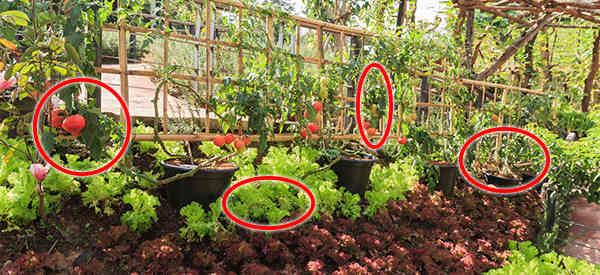Companion planting can not only help your growing plants thrive, but deter pest infestations that can greatly diminish your harvest yield. Grouping specific plants together can also help prevent nutrient depletion in soil.
Some common garden plants actually curtail the ability to thrive when they are either planted close to each other or near specific trees and bushes that are growing near your gardening areas. Keeping the border around your growing plots clear of debris and harmful trees, like the Black Walnut, will help prevent both yield problems and eliminate places harmful insects winter over or make their homes during the gardening season.
Benefits Of Companion Planting
Soil Enhancement
Using companion planting techniques to group together crops that can infuse additional nitrogen into the soil can improve your harvest.
Beneficial Insects
Not all bugs are bad. Courting beneficial bugs into your garden and providing them a home in a grouping of companion plants just might bolster your yield. Helpful insects do not eat your plants, but the bugs that dine upon them.
Physical Support
Some plants, such as pole beans, can grow steadily while providing support to other crops – in this case, corn stalks. When plants become heavily laden with vegetables, they can sag and cause breakage that will kill the plant of allow harmful bugs and bacteria to infiltrate it.
Protective Herbs And Flowers
Planting a border of specific herbs and marigold plants around the border of the garden, and in with some companion plant groups, they will protect the most important crops from harmful insects and wind damage.
Trap Crops
This type of companion planting use both herbs and ornamental plants that urge harmful bugs in their direction only to sicken or kill them after being snacked upon. Trap crops like geraniums an borage should be planted either protective herbs and flowers at the border of the garden or only several feet in front of the protective border as a first line of defense against harmful insects. Both geraniums and borage should be planted in the vicinity of crops that Japanese beetles love – like broccoli and cabbage. The scent of the plants will draw the highly destructive beetles in their direction and then kill them after being chewed upon.
Nasturtiums are also superb trap crops to ue in your companion plant layout. Beetles of nearly all types and aphids will be attracted to them. Once the nasturtiums are filled with the harmful insects, carefully remove them from the ground and drown or burn the insects.
Related: Make Your Own Peppermint Oil – The Best Insect Repellent
Shelter
When plants sensitive to either sunlight or wind, or both, are overexposed to such weather extremes, they can die within days. Following companion planting protocols, less environmentally fragile plants in a grouping can protect the others, without harming their own growing course.
Walnut Tree Dangers
These trees should never be anywhere near your garden. A single black walnut tree located within 100 feet of the growing space will destroy all of your diligent companion planting efforts.
These release juglone, a chemical compound, into the ground. Juglone provokes wilting and a yellowing of leaves – and even untimely death of otherwise healthy plants. The chemical compound in black walnut trees is present not only on branches and leaves, but in the nuts that lay on the ground. Juglone is also secreted through black walnut tree’s root system.
How much juglone is excreted by the black walnut trees will vary by season. The percentage of juglone present in the tree hits its peak as the nut start to reach maturity. It takes at least two months for the chemical to be removed from the soil after cutting down the tree.
All breeds of walnut trees make juglone, including hickory, pecan, and butternut trees, but the black walnut boasts the highest percentage of this crop killer. Plants that are the most vulnerable to juglone include tomatoes, pepper varieties, eggplant, and potatoes. Onions, corns, beets, and carrots tolerate the chemical compound better than others.
Walnut tree leaves can be composted safely but not until two weeks after they have fallen to the ground or remain on a cut branch. It takes at least 14 days for air, water, and environmental bacteria to detoxify the matter once it has been separated from the tree.
Related: 10 Trees Every Survivalist Should Know and Why
Asparagus, Cabbage, Peppers, Tomatoes, Rhubarb, Eggplant, Alfalfa, Narcissus, Potatoes, Jack in the Pulpit, Columbine, Crab Apple Trees, Chrysanthemum – select varieties, Phlox, Nectarine Trees, Cherry Trees, Bugleweed, Lilies, Hydrangea, Spiderwort ,White Birch Trees, Bellflowers, Ginger, Lilac Bushes, Plum Trees, Peach Trees, Lamb’s Ears, Hollyhocks, Rhododendrons, Hostas, Geraniums, Crocus, Wood Ferns should never be cultivated near juglone producing trees.
Garden Companion Plant Guide
After doing a walk around your garden area to clear it of walnut trees or debris bugs could thrive in, sketch out your rows or container alignment with the border areas first followed by companion plant groupings to help give your crops the best start to life – and your family a bountiful harvest.
You may also like:
24 Lost Gardening Tips from 100 Years Ago
How To Make A Year-Round Self-Sustaining Garden (Video)
















wow , great information thank you .
ron
I did notice the absence of one companion pair that was recommended by Organic Gardening Magazine nearly 40 years ago. That was onions with strawberries. That publication extolled the flavor enhancement the onions provided to the strawberries. Maybe that has changed with the times.
Onions and strawberries…I will plant them together next season, and, I will always remember this.
I first experienced companion planting accidentally a few decades ago when a friend came over and I was showing her my roses. She asked if I had aphids, and I said I didn’t. She told me I did and went to a sow thistle that was growing among them and lifted up a leaf. The underside was covered with aphids. She told me that sow thistle was a good trap plant for aphids and recommended a book on companion planting called “Carrots Love Tomatoes.” There’s a second called “Garlic Loves Roses.” If you want to know more about companion planting than this article provides, I’d recommend those two books.
Great information, but I would spell check it again.
Not to nitpick, but I think the corn stalks that provide support to the pole beans, not the other way around. Otherwise a very informative and useful article.
A classic companion planting trio is corn, pole beans, and squash, a technique historically favored by native Americans and referred to as the three sisters. The corn is planted first. When the shoots are about three inches high, the beans are planted. A couple of weeks after the beans have sprouted, the squash seeds are planted. As noted in the article, the corn provides support to the beans. The beans in turn provide nitrogen for the corn which is considered a heavy feeder. Finally, the large leaves of the squash provide shade which reduces the need for water and helps get the crop through heat spells.
Another thing with the 3 sister: The squash deters raccoons feasting on your corn since they HATE prickly things.
Great information. This will save people a lot of research. Thanks.
When one says “near such and such,” what distance is contemplated as “near”? Is that within 3 feet; or is it more than 25 feet away or some other distance?
“Near” is kind of like the anesthesiologist who, doing his pre-surgery physical asked me, “Do you drink much?
“Well, compared to whom? My alcoholic buddy? No, I hardly touch the stuff. Compared to my other buddy who is a devout Mormon, yeah, I’m on the skids to Hell.”
Near means different things to different people and is subject to too much individual interpretation.
Pretty good article. I plant plenty of marigolds and nasturtiums through out my garden. I tend to pay attention to listed companions as yields are better. Sucession planting helps too. Keeps the gardenhealthier.
I’ve practiced companion planting for years. That and crop rotation so you don’t plant the same or a related crop in the same spot two or three years in a row give stronger results and a healthier garden.
Om Sri Da. adidam.com